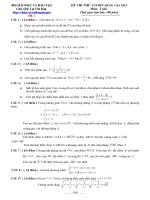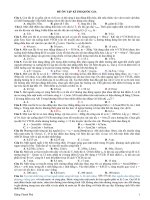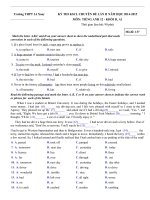Astm c 785 08 (2015)
Bạn đang xem bản rút gọn của tài liệu. Xem và tải ngay bản đầy đủ của tài liệu tại đây (76.65 KB, 3 trang )
Designation: C785 − 08 (Reapproved 2015)
Standard Specification for
Nuclear-Grade Aluminum Oxide Pellets1
This standard is issued under the fixed designation C785; the number immediately following the designation indicates the year of
original adoption or, in the case of revision, the year of last revision. A number in parentheses indicates the year of last reapproval. A
superscript epsilon (´) indicates an editorial change since the last revision or reapproval.
1. Scope
2.3 U.S. Government Document:
Code of Federal Regulations, Title 10, Part 50, Energy
(10CFR50) Domestic Licensing of Production and Utilization Facilities4
1.1 This specification applies to pellets of aluminum oxide
that may be ultimately used in a reactor core, for example, as
filler or spacers within fuel, burnable poison, or control rods. In
order to distinguish between the subject pellets and “burnable
poison” pellets, it is established that the subject pellets are not
intended to be used as neutron-absorbing material.
3. Terminology
3.1 Definitions—Terms shall be defined in accordance with
Terminology C859 except for the following:
1.2 The values stated in inch-pound units are to be regarded
as standard. The values given in parentheses are mathematical
conversions to SI units that are provided for information only
and are not considered standard.
3.2 Definitions of Terms Specific to This Standard:
3.2.1 buyer—organization issuing the purchase order.
3.2.2 pellet—fabricated geometric shape of aluminum oxide
having a chemical composition as described in Section 4.
3.2.3 pellet lot—that quantity of pellets produced from one
aluminum oxide powder lot using one set of process parameters whose limits have been agreed upon between the seller
and the buyer.
3.2.4 powder lot—a specified quantity of aluminum oxide
powder made up of powders from one or more sources,
blended together such that samples taken in accordance with
7.1 can be considered as representative of the entire specified
quantity.
3.2.5 seller—aluminum oxide pellet supplier.
2. Referenced Documents
2.1 ASTM Standards:2
C559 Test Method for Bulk Density by Physical Measurements of Manufactured Carbon and Graphite Articles
C809 Test Methods for Chemical, Mass Spectrometric, and
Spectrochemical Analysis of Nuclear-Grade Aluminum
Oxide and AluminumOxide-Boron Carbide Composite
Pellets
C859 Terminology Relating to Nuclear Materials
C1233 Practice for Determining Equivalent Boron Contents
of Nuclear Materials
E105 Practice for Probability Sampling of Materials
4. Chemical Composition
4.1 Use analytical chemistry methods in accordance with
Methods C809 or alternate methods agreed upon between the
buyer and the seller.
2.2 ANSI Standard:
ANSI/ASME NQA-1 Quality Assurance Requirements for
Nuclear Facility Applications3
4.2 The finished aluminum oxide pellets shall conform to
the following chemical analysis:
B2O3 + boric acid
Si
Fe + Cr + Ni
Mg
Na
Ca
Hf
F
F + Cl + I + Br
1
This specification is under the jurisdiction of ASTM Committee C26 on
Nuclear Fuel Cycle and is the direct responsibility of Subcommittee C26.03 on
Neutron Absorber Materials Specifications.
Current edition approved Jan. 1, 2015. Published January 2015. Originally
approved in 1976. Last previous edition approved in 2008 as C785 – 08. DOI:
10.1520/C0785-08R15.
2
For referenced ASTM standards, visit the ASTM website, www.astm.org, or
contact ASTM Customer Service at For Annual Book of ASTM
Standards volume information, refer to the standard’s Document Summary page on
the ASTM website.
3
Available from American National Standards Institute (ANSI), 25 W. 43rd St.,
4th Floor, New York, NY 10036, .
0.01 weight % max
2.0 weight % max
0.6 weight % max
1.0 weight % max
0.2 weight % max
0.3 weight % max
200 µg/g pellet max
50 µg/g pellet max
100 µg/g pellet max
4
Available from U.S. Government Printing Office Superintendent of Documents,
732 N. Capitol St., NW, Mail Stop: SDE, Washington, DC 20401, http://
www.access.gpo.gov.
Copyright © ASTM International, 100 Barr Harbor Drive, PO Box C700, West Conshohocken, PA 19428-2959. United States
1
C785 − 08 (2015)
5.4.3 Cracks—No single crack shall exceed 90° of circumference in length.
5.4.4 Fissures and other defects shall be evaluated with
respect to the criteria of 5.4.1, 5.4.2, and 5.4.3.
Any element impurity not listed in 4.2 shall not exceed 1
weight % as determined by emission spectroscopy. The sum of
all impurities shall not exceed 4.0 weight %.
4.2.1 The total equivalent boron content (EBC) of the
finished aluminum oxide pellets shall not exceed 400 mg/g on
a pellet weight basis. The total EBC is the sum of the individual
EBC values. Practice C1233 contains a list of elements to be
considered in calculating the total EBC. The EBC of each
impurity element shall be calculated individually using the
following equation:
EBC of impurity 5 ~ EBC factor! 3 ~ mg of impurity/g pellet!
6. Cleanliness
6.1 The finished pellets shall be handled in a manner to
avoid contamination by grinding fluids and dust, cleaning
agents, and organic materials such as plastics and paper used in
packaging. Cleaning solutions, if used, shall be free of halides
or nonvolatile additives and shall be removed from the pellets
prior to sampling and packaging.
(1)
4.2.2 Should the EBC of additional elements not listed
Practice C1233 be of concern, their inclusion in the summation
and their respective EBC factors must be mutually agreed upon
by the buyer and the seller.
4.2.3 The hydrogen impurity (including moisture) level,
detailed procedure for measuring hydrogen, and packaging
requirements associated with hydrogen contamination, shall be
agreed upon between the buyer and the seller.
7. Sampling
7.1 Sampling plans to meet acceptance criteria and inspection and measurement procedures that describe the method of
compliance with this specification shall be established by the
seller and shall be approved by the buyer prior to use. The
degree of sampling shall be specified in the purchase order.
Practice E105 is referenced as a guide.
7.2 Each sample taken shall be sufficient for quality verification tests, acceptance tests and archive samples, as needed.
5. Physical Properties
5.1 Physical Dimensions:
5.1.1 Dimensional requirements shall be in accordance with
applicable drawings and purchase order documents.
5.1.2 Pellet dimensions shall be measured to ensure compliance with the buyer’s requirements. Sampling plans to meet
acceptance criteria shall be agreed upon between the buyer and
the seller to ensure that the pellets represented by the sample
are within the required tolerances.
7.3 Archive samples shall be retained and disposed in
accordance with the buyer’s instructions.
8. Inspection and Certification
8.1 The seller shall inspect the material covered by this
specification and shall furnish the buyer with certificates of
tests showing the results of testing and inspection performed on
each pellet lot prior to shipment. The seller shall certify that
each pellet lot is in compliance with the provisions of this
specification.
5.2 Density:
5.2.1 Pellet density limits shall be specified by the buyer.
5.2.2 The method of density measurement shall be Test
Method C559 or an alternative method approved by the buyer
prior to use. Sampling plans to meet acceptance criteria shall
be agreed upon between the seller and the buyer. The method
of density measurement and the method of compliance with
5.2.1 shall be approved by the buyer prior to use.
9. Rejection
9.1 Unless the buyer and the seller agree otherwise, rejection and acceptance shall be on a pellet lot basis.
9.2 Pellet lots that fail to conform to the requirements of this
specification may be rejected by the buyer. The seller may
petition the buyer to waive selected requirements for identified
out-of-specification lots. Decision to grant such waiver belongs
to the buyer. The seller may also apply any remedy to bring
rejected lots into specification providing the seller can demonstrate to the buyer that such remedy does not impair the
function or preclude the certification of the rejected material.
5.3 Mechanical Properties—Required mechanical properties and test methods shall be mutually agreed upon between
the buyer and the seller.
5.4 Visual Appearance—Visual examination shall be conducted on finished pellets in accordance with Section 7. The
seller and the buyer shall agree on visual standards as representing the requirements of 5.4.1, 5.4.2, and 5.4.3. These
standards shall be used as acceptance standards for the visual
examination of the pellets. In the event of a dispute, the method
of defect measurement shall be submitted by the seller for
approval by the buyer. Maximum permissible defects are
defined as follows:
5.4.1 End Chips—Pellet end surface shall not be chipped
beyond 10 % of the end-face surface area and no chip shall
exceed 1.0 mm (0.040 in.) in depth.
5.4.2 Circumferential Chips—Pellet circumferential surfaces shall not be chipped beyond 5 % of the circumferential
surface area. No single chip shall exceed a depth of 1.0 mm
(0.040 in.).
9.3 In the event of disagreement over the results of analysis,
samples shall be submitted to a mutually selected referee for
resolution.
10. Packaging and Shipping
10.1 The pellets shall be packaged in sealed containers for
shipment from the seller to the buyer. The seller shall be
responsible for using the shipping container to assure the
pellets arrive still in conformance with this specification, and to
assure reasonable ease of unpacking.
10.2 Each container shall be clearly marked with the following:
2
C785 − 08 (2015)
10.2.1
10.2.2
10.2.3
10.2.4
10.2.5
Aluminum oxide pellets,
Purchase order number,
Gross, tare, and net weights,
Lot number, and
Name of manufacturer.
12. Keywords
12.1 Al2O3; aluminum oxide; filler pellets; spacer pellets;
spacers
11. Quality Assurance
11.1 Quality assurance requirements shall be specified in the
purchase order. Code of Federal Regulations Title 10, Part 50,
Appendix B and NQA-1 are referenced as guides.
ASTM International takes no position respecting the validity of any patent rights asserted in connection with any item mentioned
in this standard. Users of this standard are expressly advised that determination of the validity of any such patent rights, and the risk
of infringement of such rights, are entirely their own responsibility.
This standard is subject to revision at any time by the responsible technical committee and must be reviewed every five years and
if not revised, either reapproved or withdrawn. Your comments are invited either for revision of this standard or for additional standards
and should be addressed to ASTM International Headquarters. Your comments will receive careful consideration at a meeting of the
responsible technical committee, which you may attend. If you feel that your comments have not received a fair hearing you should
make your views known to the ASTM Committee on Standards, at the address shown below.
This standard is copyrighted by ASTM International, 100 Barr Harbor Drive, PO Box C700, West Conshohocken, PA 19428-2959,
United States. Individual reprints (single or multiple copies) of this standard may be obtained by contacting ASTM at the above
address or at 610-832-9585 (phone), 610-832-9555 (fax), or (e-mail); or through the ASTM website
(www.astm.org). Permission rights to photocopy the standard may also be secured from the Copyright Clearance Center, 222
Rosewood Drive, Danvers, MA 01923, Tel: (978) 646-2600; />
3









